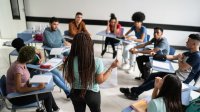Incorporating Vision Boards in World Language Classes
Creating a vision board guides students to contemplate their life goals and work on the target language.
As a veteran educator, I find myself constantly in search of ways to feel inspired. Last year, I created a vision board as part of a workshop focused on teacher wellness. With a pair of scissors, a poster board, a glue stick, and some decorative scrapbook paper, I spent the day looking through stacks of magazines and newspapers, cutting out words or images that stood out to me.
As the workshop facilitator advised, I focused on the words and images that caught my eye and reflected my goals and aspirations. The experience was more powerful and meaningful than I could have imagined and immediately got me thinking about how I could adapt this to my world language classroom.
The last few years, I have noticed on several occasions that my high school students still enjoy and appreciate opportunities to be creative in the classroom. Their faces light up anytime I bring out colored pencils or markers.
It’s no secret that our students—just like their teachers—are often overwhelmed and overscheduled and would greatly benefit from partaking in more wellness- and mindfulness-oriented activities. So, a crafty and artsy project like this one was likely to appeal to them. Scissors, glue sticks, magazines, newspapers, decorative scrapbook paper, and small poster boards were all the materials needed.
An Analog Activity
While I fleetingly considered having students create a digital vision board, I felt that there was value in the acts of physically cutting out the words and images and arranging them on the poster. I liked the idea that there would be no computer- or internet-related distractions during the project, so that all of my students could mindfully engage in it and appreciate the textures and other sensory elements involved. I also wanted them to be able to display their handmade creations at home.
After showing the students my model and explaining my own vision board, I first asked my students to home in on their goals. Just as the facilitator had done in my workshop, I encouraged them to find the words and images that inspired them or conveyed their goals in some way.
Combining Vision Boards and Language Learning
The main challenge then became, how could I infuse language learning into this task?
I knew that I could try to get my hands on as many magazines and newspapers in Spanish as I could, but that didn’t seem like the most practical option. I decided that as students were working and crafting, I would informally check in with each of them to ask them what images or text they were selecting and how they were inspired. However, I quickly determined that the opportunity for rich language use would come into play once the vision boards were created.
In an effort to practice the future and conditional tenses in my intermediate-level Spanish classes, I would have them use their vision boards as the basis for a presentational speaking activity. Providing students with modeled examples was important, and since I had made my own vision board, I was able to do that.
I started off by pointing to the word “travel” because I plan to travel to a variety of different countries in the future to experience new cultures. I explained that I hope to visit Japan and also would love to revisit Spain, France, and England. I then pointed to the phrase “the bright side” because it encourages me to maintain a positive mindset even amid obstacles. The next time I am feeling stressed or overwhelmed, I will look at this phrase and I will remember to just breathe and find the silver lining in any negative situation.
Following my model, I encouraged them to go about their presentations in this way while incorporating a variety of transitional phrases. I arranged them into groups of three or four and set the timer, giving each student two to three minutes to speak about their vision boards and how their images or text represented their future goals.
An interpersonal element would be added after each member of the group was finished showing and presenting their vision board. I instructed that every student needed to formulate a specific question to ask each group member about their specific board. Once the interpersonal Q&A was complete, as the final task, I would have students write a brief reflection explaining what inspired them or intrigued them from their group mates’ vision boards and why, which we could later share as a class.
This vision board project became a mini-unit unto itself to be broken up over several days’ lessons. Additionally, the logistics of the presentational component could be altered—rather than having students present in groups, they could do so individually in front of the class or through a recording. They could also create a piece of presentational writing about their vision board in which they wrote about their hopes, dreams, goals, and future plans rather than speaking about them.
Although the tasks can be varied in countless ways, the foundational piece of creating the vision board is immensely meaningful to students and can give way to authentic target language use. This allows you to reach and engage all of your learners while giving them a rare chance to slow down and reflect on what inspires them.
